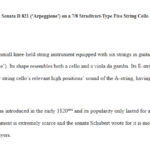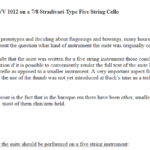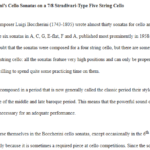- 2015-11-1
- CONCLUSIONS ABOUT THE GENERAL USE AND FUTURE OF THE FIVE STRING CELLO., IV. FINAL TESTS AND CONCLUSIONS
- 5string, five string cello;suite bwv 1012
FINAL CONCLUSIONS ABOUT THE GENERAL USE AND FUTURE OF THE FIVE STRING CELLO
When the final instrument was finished Doll started in the last weeks of October 2015 to ‘break it in’ by playing it daily with the strongest possible sound – mostly using open strings to produce a maximum of overtones.
NOVEMBER 2015
After playing the new cello for about one month it became obvious that the instrument basically suffers from the same impediments as both prototypes: While it has overall a much better sound quality there is a noticeable loss of volume on the higher registers of the G- and D-string compared to a four string cello. The quality and volume of the E-string improved to a considerable degree but the nasal character is still clearly noticeable.
JANUARY 2016
After having tested the prototypes and having played the final instrument for more than two months several conclusions can be drawn:
ACOUSTIC OBSERVATIONS
All of the three instruments have a nasal sound character on the upper strings, especially on the E-string. The final cello has by far the best sound properties, the mentioned nasal character however basically remains the same.
All of the three instruments have acoustic problems in the higher positions of G- and D-strings, resulting in volume loss and numerous wolf notes. Again, the final instrument has the best sound properties but shows the same acoustic problems, however to a smaller degree.
Basically, especially considering the high strings, even a master-made five string cello seems to end up with a sound character resembling more a viol’s than a four string cello’s. The low strings’ sound is closer to a four string cello’s but lack quality to some degree, especially in the higher positions.
TECHNICAL PERFORMANCE AND STILISTIC OBSERVATIONS
When playing pieces intended for a five string instrument (For a list of pieces for which the use of a five string cello could be appropriate see Appendix D.) the advantage of using a five string cello is undeniable. As shown in detail in the next paragraph the presence of the fifth string facilitates playing such pieces to a tremendous degree compared to playing them on a four string cello. While the use of a four string cello requires the frequent use of very high and unnatural positions almost all high passages can be played in convenient positions on the E-string of a five string cello. (Exceptions are pieces that were composed for significantly smaller instruments, such as the Suite BWV 1012 and the Arpeggione Sonata. In those pieces sometimes still the use of the thumb is necessary and high positions even on the E-string cannot be avoided.)
Stylistically there is no problem whatsoever when performing pieces for five string instruments on a five string cello: Most of the available music is composed for some instrument of the viol family which members all have a sound very similar to the instruments of this project. (The Arpeggione was a rather small instrument in guitar tuning. There are very few originals left, usually not available for playing, but modern replicas also sound very similar to viols. The BWV 1012 might be an exception: The replicas of the instrument it most likely was intended for (viola da spalla) sound more like a viola than a viol.) The fifth string allows a performance in adequate tempos while using a four string cello often forces to compromises on account of frequent and big shifts.
When playing pieces composed for a four string cello the use of a fife string cello proved to be less helpful than expected. Playing Baroque sonatas that were obviously intended for a four string instrument the E-string does not help much because high positions are very rarely used: Usually their tonal range does not exceed the fourth position on the A-string. (The nasal sound quality does not really present any stylistic problem with these kinds of pieces; neither does the lack of volume since they were not written for performances in big halls.)
When playing classical or romantic pieces on a five string cello several problems became obvious: While the E-string string allows the use of lower positions where a four string cello player has to use high thumb positions the shift system becomes completely different. The use of the traditional education of a four string cellist becomes almost useless. All fingerings of etudes, sonatas and concertos would have have to be re-written and practiced anew. The same is true for the entire orchestra literature. A four string cellist, willing to change permanently to a five string cello and using it for pieces of all époques would have to ‘re-learn’ quite a big part of his technique. He also would probably have to quit using a four string cello altogether because the newly acquired technique wouldn’t apply to a four string cello anymore..
Stylistically there are two major problems when using a five string cello for playing classical and romantic pieces that were composed for four string cellos: The viol-like sound quality and the loss of overall volume. Those two factors weigh rather heavily against the use of a five string cello in general use for this kind of music. When using five string celli in a symphony orchestra the sound quality of the section would be very different from the rest of the strings. The smaller sound also would probably require a bigger section size. As for solo- and chamber music: modern halls are quite big and the public taste nowadays usually connects viol-like sound quality to Renaissance- and Baroque music.
FINAL CONCLUSIONS ABOUT THE PERMANENT USE OF A FIVE STRING CELLO
As a solo- or orchestra instrument the five string cello is not likely to replace the four string cello. The main reasons for this are the loss of overall sound volume, the difference of sound quality and the different shifting patterns. The latter factor could be overcome through intensive practicing in order to rebuild the traditional shifting system in the high registers. However this effort would be a waste of time when the instrument would be intended to be used for performing classical and romantic music: a five string cello’s sound property compares unfavorably to a four string’s when approaching this kind of music; it cannot really successfully compete with a quality four string cello. The notes in high registers on the A-string of a four string cello sound much stronger and clearer than the relevant notes on the E-string. (However, the four string cello as an instrument to perform the BWV 1012 will probably be slowly replaced by viola da spallas of various types.)
The circumstances change completely when approaching works composed for five string instruments. The problem with different shifting patterns becomes non-existent because the fifth string was taken into consideration from the beginning of the creation of those pieces. They mostly were written for viols (usually equipped with six strings, tuned in fourths and thirds), not for a fifth-tuned five string cello, but this point is almost of no relevance since the tonal range is basically the same. With the exception of Bach’s Suite BWV 1012 and Schubert’s Arpeggione sonata (both pieces were presumably written for small, arm-held instruments) such pieces can be throughout performed in comfortable positions – the use of the thumb positions is not necessary, which coincides with the fact that thumb positions were and are not used with viols. A new and rather big repertoire opens itself for the user of a five string cello that is usually not approached by four string cellists because of the extreme technical problems.
As mentioned before there are no stylistic problems with performing viol pieces on a five string cello: the sound properties are very similar and the pieces, ideally performed with the accompaniment of a cembalo, can be performed in a small hall as they were intended to.
The performance of Bach’s BWV 1012 and Schubert’s Arpeggione will be considerably easier when using a five string cello. This fact would make a five string cello the best choice for a cellist used to the Stradivari-size cello. . However, there still remain some technical difficulties that would not occur when the pieces would be performed on the original instruments.
The ultimate conclusion of reached by this project consists of the fact that even a high-level five string cello is not likely to replace the four string cello and that the development of the four string cello as the dominant cello type was justified.
However, it is highly recommendable to use a five string cello for pieces that are written originally for five stringed instruments since it allows a natural and stylistically correct performance of such pieces.Owning a five string cello makes a wealth of beautiful pieces available that, if at all, are usually only touched by viol players.
However, it is not to be expected that after reading this study many cellists will invest in a new, master-made five string cello. This probably means that in the future the count of Stradivary-type five string cellos will not change dramatically.
For cellists who cannot afford to have a master instrument built there are still the possibilities to have a cheap four string cello turned into a five string instrument (like the two prototypes of this project) or equip a four string cello with the strings e’,a,d,G and transpose the notes on the missing C-string one octave higher. (If you want a fingered version of the Suite BWV 10212 where the transposition is already done please contact us.)
It is not recommended to change a valuable four string cello into a five string cello becauise there are major quality changes to expect.
Since this project has led to a clear conclusion we consider it a success and are convinced that it will be helpful for many cellists who have engaged themselves in the matter of five stringed instruments.
We want to express our sincere thanks to the Japan Society for the Promotion of Science for financing this project, Kazuhiro Kaneko for his help with many difficult bureaucratic procedures, Yoshio Ueda for his meticulous work, Noburo Morishige for his kind assistance with many photographs and Ayumi Kimura for the homepage- and computer assistance.
General tips for playing a five string cello
– Probably the biggest problem when playing a five string cello is to change strings by crossing over one or more other strings. Especially in the first weeks, even months often the D- and G-String will be mixed up, by the right as well as the left hand. One method to avoid such misses is to try to place the left hand before the bow on the string that has to be changed to. This helps the right hand to some extent to ‘find’ the string. Another method is to memorize the relevant places and actually look right at the string shortly before the change. If a string change leads back to a previously used string it helps to keep the finger(s) there during the change, even if actually a different finger or position will be used.
– Another problem is the fact that usually on a five string cello the strings are a little closer to each other than on a four sting cello. (This is because the bridge would become too massive if a four string cello’s measures would be kept.) This might sometimes result in the bow’s accidental touching of other strings. It is therefore recommended to play generally quite close to the bridge and keep the bow always in the optimal level.
– Generally the use of ‘long strings’ (low positions) is advisable when playing Baroque pieces. The unfavorable properties of a five string cello’s 3rd and 4th positions make this an absolute must: whenever possible the low positions should be used.
– As mentioned above it is recommended to use a five string cello for pieces that were written for five string instruments. This makes pieces for viol the obvious choice. In spite of the fact that there are nowadays rather few viol players quite a lot of pieces are still available, on the internet as well as in commercial editions. – The E string should be wiped frequently because even a small amount of resin stuck to it affects the sound quality negatively.
(In the next paragraphs pieces played with a five string cello are discussed in detail.)



